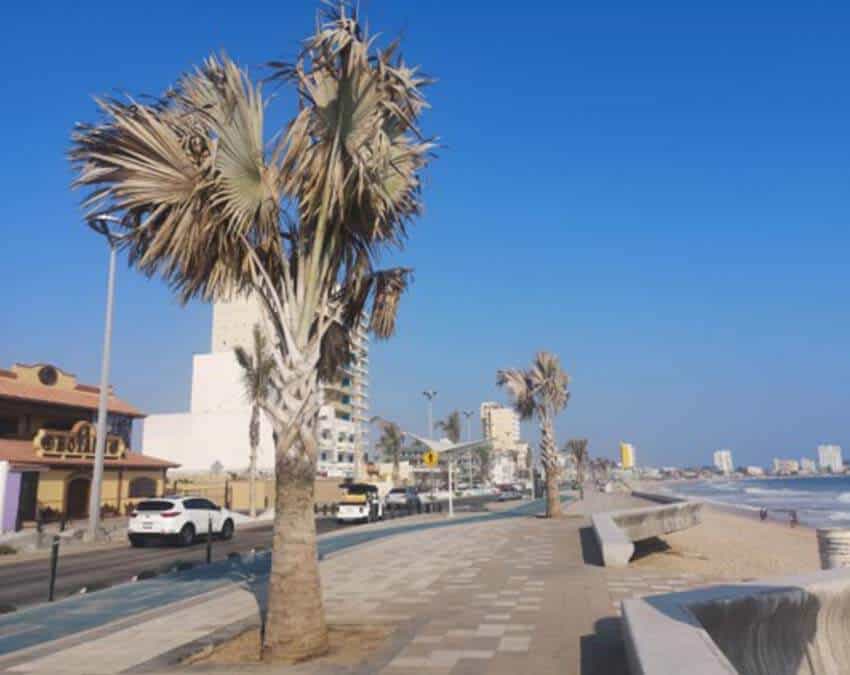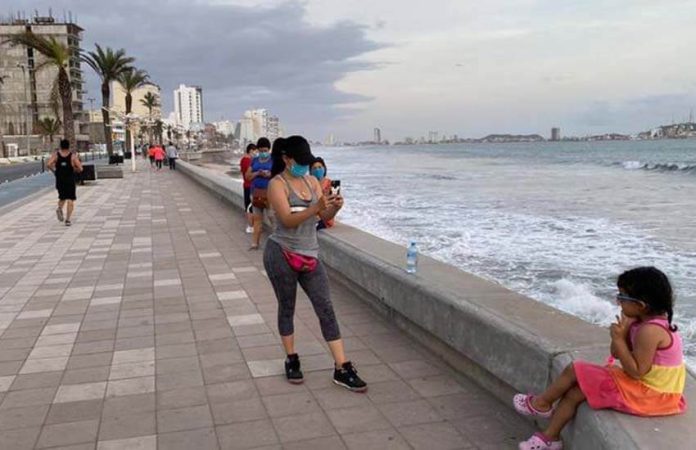Several years ago, the city of Mazatlán launched a beautification project to make the city more attractive to tourists. One of the first big steps was to plant 115 coconut palms along a 4.5-kilometer stretch of the malecón, the concrete boardwalk between the Gold Zone and Olas Altas at the edge of the historic center.
When I first heard of this project, I remembered a statistic about falling coconuts killing 10 times more people than sharks — that’s sharks in the ocean, not falling sharks.
Ornamentation with a potential body count — I liked it already.
Since I ride my bicycle along this stretch of waterfront several times a week, I watched this construction parody, from the chalk marks on the concrete to the towering palms with their stainless-steel accent lighting. It was an excellent lesson in the economics of Mexican public works.
I have, in one form or another, been in the construction industry for about 40 years, mostly on the commercial side; so let’s say I have a basic understanding. Thus I know that laying out a simple square on a flat concrete surface is a skill that should be possessed by most apprentice masons, all journey-level masons and, you would think, all architects and engineers.

But are perfect squares all that important in the overall scheme of things? If the squares vary an inch here or there, does it really matter? I mean, these things were just holes to put palm trees into, right? How hard could it be to plant a bunch of palm trees along flat surfaces with great access?
Anybody could do it — right?
One of the primary rules when doing repetitious work is maintaining a common geometry so that the finished product is pleasant to the eye. Laying out something symmetrically allows the use of pre-made patterns and simple math, which can be repeated at every hole the same way, simple in its consistency — dare I say it: idiot-proof.
The squares would need a common point of alignment so that they will all be visually in sync when complete. Using the straight edge of the malecón/sea wall on the ocean side or the straight edge of the curb on the street side would be quick and simple. It would allow the square holes to share two parallel sides with either the curb or the seawall, thereby assuring close-to-perfect symmetry.
However, the city had its own cunning plan for creating holes and planting palm trees.
The first to appear were a pair of two-man crews, each with 16-inch, walk-behind concrete saws.
Each crew was responsible for drawing its own version of a square on the concrete prior to making the cuts. I watched as the cutting went on for a week before someone realized that the holes were too small to accommodate a full-grown palm tree.
Plan B: instead of enlarging the holes with the concrete saws, they brought in a backhoe with a hydraulic jackhammer on the articulating arm. So the backhoe hammered out the holes well past the saw-cut lines, thereby rendering the saw-cut process wasted time and money.
As the backhoe worked its way down the malecón, the intense vibrations from the jackhammer attachment were transferred through the machine to the tires on the ground. The vibrations from this operation were so intense, they settled the sand that supports the concrete slabs that comprise the boardwalk.
This caused portions of the concrete pathway to collapse several inches into the shallow voids created by the settling.
Plan C: the backhoe was then placed into the closest traffic lane to do the work while traffic was shunted around the working equipment. This must have caused complaints because the backhoe was back on the malecón a week later.
By now, the concrete cutting crew had returned and were cutting straight lines just outside the jagged destruction created by the backhoe’s jackhammer attachment. This time, the problem was that they did not cut completely through the concrete, so the backhoe with the hammer had to come and finish off the holes.

This caused divots or even chunks to be knocked out of the concrete walkway beyond the saw cut, thereby rendering this saw-cut process more wasted time and money.
As all this was taking place, there was another concrete-saw crew cutting a trench between the tree well holes to accommodate an electrical conduit.
The conduit-laying crew must have been kept in the dark as to where to place the conduit stub-outs at the tree well because there was no consistency whatsoever. The black pipe stubs were mostly in the general area of the soon-to-be-formed tree wells.
After the palm trees were inserted into their holes, the masons were sent in to give each tree well four straight sides, in an attempt to make them appear to be squares, which should have happened with the first round of saw cuts.
After watching the masons for a few days, I realized no one had informed them that the black pieces of pipe that were sticking up needed to be inside the tree well, not on the sidewalk.
During the next several days, there was another two-man saw crew out cutting the sidewalk so that the electrical conduit that had been cast into it could be moved to inside the tree wells.
At this point — two months into this poorly managed circus — the vast majority of the holes had become parallelograms and trapezoids with very few palms actually centered in the geometric blunders.
This probably would not have mattered much if the final plan had not called for a two-piece, stainless-steel grate with a hole in the center to be installed perfectly flush with the surface of the malecón. I am sure there was a set of plans somewhere that contained drawings of just how impeccably perfect the finished project would look.
The first stainless-steel grill was fitted at the north end of the project and looked to be custom-made for that particular tree well. I am sure that whoever submitted the bid to supply 115 stainless-steel grates, all exactly the same size, was recoiling vigorously. Needless to say, there were no more stainless-steel grates filling the remaining 114 quadrangles.
The accent lights and associated conduit started going up about a week after the single grate appeared. Both the lights and the conduit are held by stainless-steel straps that encircle the trunk of the palm and are quite tight.
I am not sure just what will occur when the palms grow, but these are trifling details to be dealt with by the next city administration.
If from the beginning this project had had just one competent person involved for even a couple of hours per day, significant time and money would have been saved. But this is Mexico, where it is more important to keep people working and where competence can give way to a bit of cronyism and a complete lack of circumspection.

The end result is a malecón with palm trees fluttering in the balmy tropical breezes. And the growing coconuts will provide a whole new opportunity for fun in the sun.
And only obsessive-compulsive gringos like myself will ever notice any of the discrepancies.
The writer describes himself as a very middle-aged man who lives full-time in Mazatlán with a captured tourist woman and the ghost of a half-wild dog. He can be reached at [email protected].
